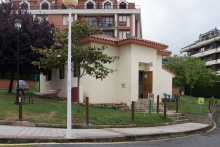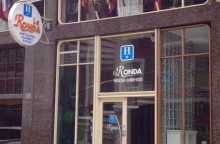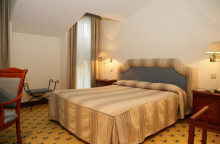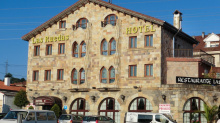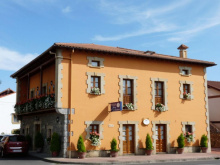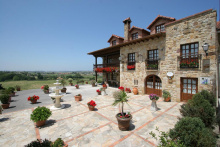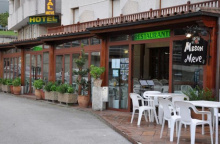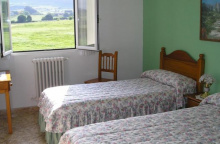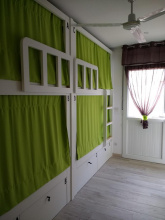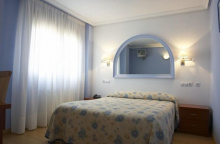The Camino del Norte
In Cantabria
The Norte in the Basque Country
▶ The Norte in Cantabria
The Norte in Asturias
The Norte in Galicia
Accommodation Directory
Direct to Castro Urdiales via Mioño along the coast. 7.1km
In Ontón the camino climbs a set of stairs to bring you back up to the level of the N-634, at a point where the road curves sharply and arrows point in two distinct directions.
Option 1: Along N-634 through Mioño & tunnel- 7.1
To follow the new route, simply follow the bend in the road and keep on it as it twists and turns. It will cross under and over the A-8 several times before arriving in Mioño.
Option 2: The Old Camino - 14.8
The old camino route crossed over the N-634 at this bend, and followed the CA-523 in the direction of Baltezana. The way is still well marked but has been largely abandoned in favor of a newly marked route along the N-634.
There is a variant here which directs you to leave the N-634 before arriving into Mioño. It takes you to Castro Urdiales via the coast.
In Mioño the camino leaves the N-634 by turning left just before the church, following the signs to the Asador El Tunel. Just past the Asador (a bar and restaurant) is the Tunel, an 800m path cut through the mountainside. At the other end are the southern suburbs of Castro Urdiales, which you will enter along the N-634 (which went around the mountain as you went through it).
Original camino via Santullan, inland route is 14.8 to Castro Urdiales
Both Routes rejoin in Castro Urdiales
The life of Castro Urdiales still revolves around the puebla vieja, or old village. It is here that you can explore the most impressive and oldest monuments.
Iglesia de Santa Maria perched up high. Nearby is the Faro y Castillo de Santa Ana, the Medieval Puente Romano, and the Ermita Santa Ana. When you are done exploring hustle back to the Plaza Del Ayuntamiento for a fill-up.
Castro Urdiales was settled first by the Romans, who used the location more for its iron than the sea. It prospered under the reign of the Kingdom of Castile right up until 1813 when the French Army destroyed the city. It was quickly rebuilt and fortified.
June: San Juan on the 24th, and San Pelayo Mártir (the patron of Castro Urdiales) on the 26th.
July: La Virgen del Carmen on the 16th, and Santa Ana on the 26th.
August: The Assumption of Mary is celebrated on the 14th.
November: San Andrés on the 30th.
The camino through Castro Urdiales follows the N-634 but it is possible to walk the coastline, a route which is a great deal more scenic. It can be followed as far as the beach at which point you will need to turn back towards the main road. A short distance later the camino turns left towards the Plaza de Toros; the municipal albergue is located at this end of town behind the bull ring.
After passing the Plaza de Toros (on your right) the camino arrives at a tunnel under the A-8; large signs for CAMPING let you know that you are on the right track. Eventually, you will pass the camping, and a short distance afterward, Allendelagua.
Accommodation in Castro Urdiales.

From Allendelagua the camino turns left, and follows a road that is parallel to the A-8. It turns right to cross under it at the first opportunity. After the underpass it leaves the paved road for a path that cuts up through the forest and into Cerdigo, passing the Iglesia de San Juan Evanjelista along the way.
At the far end of Cerdigo the camino crosses the N-634 where it picks up a coastal path. You will pass the Cerdigo cemetery along the way, eventually rejoining a smaller road that parallels the N-634 and into the town of Islares.
The first building you come to in Islares is the church, and to your right is the albergue (which may or may not be open). The hotels in town are located along the N-634, which you will eventually rejoin as the camino reaches the end of the town.
Islares is stretched out along the coast and held in place by the road and mountain to the south. The Iglesia de San Martín and is one of the first buildings you come to.
When leaving Islares exercise caution along the N-634. There is no dedicated place for pedestrians along this stretch.
Accommodation in Islares.
| Islares Hostel 25€ 14 |

|
| Camping Playa Arenillas 12€ Booking.com |
| Hotel Arenillas ⭑⭑ |

The albergue is currently closed, but you may find some luck getting a private room at the bar. Other pilgrims have reported 20€.
January: San Vicente Mártir on the 22nd.
May: San Isidro Labrador on the 15th.
June: San Juan on the 24th.
August: Las Nieves, patron of El Pontarrón, on the 5th. San Mamés on the 7th.
The camino splits in El Pontarrón. The official route continues due south along a pedestrian path adjacent to the main road (which becomes the CA-151) and a coastal option follows the N-634 across the river.
High up on the hillside on the south side of town is the 17th century Iglesia de San Vicente de la Maza; unfortunately its remote location in the hillside forest means that there is seldom someone available to unlock the doors.
After Rioseco, the camino continues to the first roundabout and turns right to cross the river and enter the small hamlet of La Magdalena.
Accommodation in Rioseco.
| Posada Valle de Guriezo |
| Posada Fernanda Booking.com |

|


17th century Iglesia de La Magdalena.
La Magdalena is celebrated on the 22nd of July.
The camino leaves the main road at the church in La Magdalena, turning right and uphill to follow the trail over the hillside. When it descends it passes under the A-8 and enters the area known as Liendo.

Hazas is the center of the Liendo area, a collection of towns spread out across this broad valley. As such it has most of the services you need. The Iglesia de Nuestra Señora de la Asunción stands opposite the albergue.
From the albergue the camino climbs up to join the N-634, turning left to follow it a short distance. When it splits the official camino turns left to leave the main road and descend to Tarrueza. You can alternatively keep on the N-634 on a shorter course to Laredo; this option will rejoin the official camino at a large junction.
Accommodation in Hazas - Liendo.

After Tarrueza the camino crosses back over the A-8 and at a large roundabout junction with the N-634 it leaves the busy road for a side road uphill. There is only one clear way across this large roundabout, to your right, and the road uphill is the first obvious choice. The road takes you towards an unsightly tower. Immediately after it turns left downhill to cross directly over the N-634 to a set of stairs. These stairs descend through the Puerta de San Lorenzo directly into the old town of Laredo.
Laredo is a popular tourist town, drawing beachgoers to its 5km of beachfront. The camino brings you through the old town but sort of goes around the best parts. Take your time to explore a bit before setting off down the long beach. In the old town, you will find the Iglesia de Santa María de la Asunción.
July: Día del Carmen on the 16th.
August: La Batalla de Flores (the battle of flowers) sees large flower covered floats parading and is held on the last Friday, and San Roque (the patron of Laredo) on the 16th of August.
In Laredo the camino follows two options, and in this instance the alternate route is part of a series of options that appear further to the west.
At issue is the best way to cross the broad estuary between Laredo and Santoña. The official camino requires the use of a ferry between the two, a journey which may not suit everyone.
As a result, a web of alternative routes has been created. Between them, there does not appear to be any preferred way to rejoin the official camino. There is an option to rejoin in Santoña (passing the municipal albergue west of town) and another to rejoin in San Miguel de Meruelo. Adding to these options is the fact that beyond Santoña, in Berria, the camino splits again for safety reasons. The options from Berria can merge with the second option above, also to rejoin the official camino in San Miguel. Those options are described with Berria.
Distances in [brackets] are the total from Laredo to San Miguel de Meruelo.
Option 1: To Satoña via ferry (official) - 5.9 [20.6]
On your left after passing under the Puerta de San Lorenzo is the Convento de las Trinitarias, on the Calle San Francisco. This road ends at a large intersection and a plaza of sorts with a fountain in the middle. You need to get to the other side and the easiest way to do that is to walk counter clockwise around the intersection. After passing the old Ayuntamiento with the 3 arches, cross one more street to follow the Calle de López Seña. You want to be going in the direction of the Paseo Maritimo and the Playas, NOT the Puerto. Note that at this point you are leaving the old town behind. Soon you will begin walking along the Paseo Maritimo, the path adjacent to Laredo’s long beach. At the far end of the beach, over 4km later, is the restaurant and boat launch at El Puntal.
Option 2: To Santoña by land - 13.9 [28.7]
The shortest route to rejoin the official camino is to follow the road to Colindres, and then again to Santoña. This brings you into town over the bridge, passing the Municipal Albergue along the way.
Option 3: To San Miguel de Meruelo - 19.4 [19.4]
If you did not take the ferry, it is more likely that you chose this option to rejoin the camino in San Miguel de Meruelos; and in so doing bypass Santoña, Berria, and Noja. The route is along the road and there are two albergues along the way.
Accommodation in Laredo.


To Satoña via ferry (official) - 5.9 [20.6]
On your left after passing under the Puerta de San Lorenzo is the Convento de las Trinitarias, on the Calle San Francisco. This road ends at a large intersection and a plaza of sorts with a fountain in the middle. You need to get to the other side and the easiest way to do that is to walk counter clockwise around the intersection. After passing the old Ayuntamiento with the 3 arches, cross one more street to follow the Calle de López Seña. You want to be going in the direction of the Paseo Maritimo and the Playas, NOT the Puerto. Note that at this point you are leaving the old town behind. Soon you will begin walking along the Paseo Maritimo, the path adjacent to Laredo’s long beach. At the far end of the beach, over 4km later, is the restaurant and boat launch at El Puntal.
Note that the distance to the center of Santoña includes the water crossing, a distance of about 600m. The ferry will deliver you to the south shores of Santoña, where you cross through the park and into the city.

Santoña is surrounded by the Cantabrian Sea on three sides, and has a mountain on the fourth; so it is no wonder that the economy here is much to do about fishing, canning, and seafaring. From the docks and the monument to Juan de la Cosa, it is a straight path through town. The Iglesia de Santa María del Puerto is not on the camino proper but does merit a visit.
The Iglesia de Santa María del Puerto, which dates from the 13th century, was built in the same location as an earlier 8th century Benedictine Monastery which itself is rumored to have been built at the location of a church founded by Santiago himself in the year 37.
The monument at the port is dedicated to the most important cartographer of the 15th century, one Juan de la Cosa. His name probably doesn’t ring a bell, but here is a guy that the textbooks forgot to tell you about. He is credited with having created the first map of the Americas (a piece commissioned by the Catholic Monarchs), and the only one ever to be created by someone who witnessed first hand the first voyage of Columbus. Juan was the captain and the owner of the Santa María.
Five centuries after Juan de la Cosa left Santoña for the new world by ship, his 20th century counterpart returned by sea plane. Charles Lindbergh landed Albatros off shore in 1933, forced down by the weather while en route to Lisbon. The town spared no expense to accommodate he and his wife.
From the ferry terminal, with your back to the water, walk straight into the city. You will pass through the Plaza San Antonio and then the large Manzanedo Park. Keep going straight when you get to the first roundabout (bus terminal here) and at the next one do the same; you are looking for the least busy northbound road. From this roundabout, it is a straight path to Berria. At the entrance to town is the high-walled El Dueso prison.
Accommodation in Santoña.

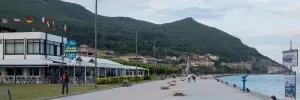
The town of Berria has been built on an isthmus that was formed by dueling north winds. The beach here is a popular day tourist destination.
At the end of Berria, the camino splits. This is one of the rare points where the official camino might not be the best option. Where the main road turns left at the end of town, the camino turns right onto a trail which climbs 100m up to the top of the El Brusco headland. Although this climb affords excellent panoramic views from the top, its steep sandy terrain is not for the faint of heart.
The alternative is to follow the road to Noja.
The official camino over the Alto de Brusco is straightforward. To follow the alternative along the road, turn left at the bend to follow a pedestrian path past the first roundabout. At the second roundabout bear right to follow the CA-141 in the direction of Somo. There exist several variants of the camino along this stretch, which may accidentally take you away from Noja and to San Miguel de Meruelo.
All of these options require you to turn left off of the CA-141 so if Noja is your destination, keep on the main road and ignore all left-hand turns. When you do leave the CA-141 it will be to the right and is marked Helgueras 2km.
If neither Helgueras, Noja, nor Castillo are on your agenda you can follow the left facing arrows and continue directly to San Miguel.
Accommodation in Berria.
| Albergue Playa de Berria 22€ 22 Booking.com |

|
| Posada Las Garzas Booking.com |

|
The Noja beach begins here in Helgueras, a quiet surfers hideout.
When you get to the beach in Helgueras the camino resumes across the sands and up to Noja.

Noja is straddled by two fine beaches and a topography which has kept the town from over expanding. The Iglesia de San Pedro is the highest point in town; it is surrounded by a bit of green space for resting and is across the street from the tourist information office and the Plaza de la Villa.
San Emeterio and San Celedonio are celebrated on the 29th of August.
The camino enters Noja along the park adjacent to the beach, and turns left at the far end to follow the road uphill into the center of town. It passes around the Iglesia de San Pedro and then winds its way back down to the CA-141 which it crosses into Castillo.
Accommodation in Noja.
The camino winds along a paved side road between Castillo and San Miguel.
Accommodation in Castillo Siete Villas (Arnuero).
To San Miguel de Meruelo - 19.4 [19.4]
If you did not take the ferry, it is more likely that you chose this option to rejoin the camino in San Miguel de Meruelos; and in so doing bypass Santoña, Berria, and Noja. The route is along the road and there are two albergues along the way.
June: San Juan, the patron of Colindres, on the 24th.
July: El Carmen on the 16th and Santiago on the 25th.
August: San Roque on the 16th and San Ginés on the 25th.
Accommodation in Colindres.
| Albergue de peregrinos de Colindres 6€ 18 |
| Hospedería el Puerto Booking.com |

|
Accommodation in Gama.
| Albergue de peregrinos de Gama 4€ 12 |
The alternative routes from Laredo all merge here. Most services are along the main road where there are also misleadings signs to the curiously niche Museo de la Campana (bell museum). The museum exists but is in the next town over.
If you need any of the shops in town, stay on the main road when you reach the town. All of the services are located at the start of town along this road, which you can follow to the end of town and resume the official camino.
San Mamés is celebrated on the 7th of August.
The camino passes through San Miguel on a small country road at the upper side of town. It passes the church before descending back to the CA-454 which it follows a short distance before turning left downhill at the end of town. From here it descends to the bottom of the valley, where the albergue is located, and then climbs back up to the road in Bareyo.
Accommodation in San Miguel de Meruelo.
| Hostería Sol Booking.com |

|
Bareyo is the heart of a district know for having produced world class stone masons, bell makers, and retablists whose work can be seen and heard throughout the peninsula. Among them is Juan de Herrera who was responsible for the cloister that is part of the Cathedral in Santiago. Incredibly, little of their work can be found in Cantabria itself.
The nearby 12th century Iglesia de Santa María is one of the few examples of Romanesque architecture to be found in the area, and it has been well preserved.
In Bareyo it is possible to take a small detour (signposted and along the road) to visit the 12th century Iglesia de Santa Maria. Otherwise, turn left at the road.
Ahead the camino takes a long route around Güemes, in fact it doesn’t much go through town at all. This is fine if you are planning on staying at the albergue here as it is on the camino, but otherwise it is possible to keep on the road as it passes through Güemes on a shorter route to rejoin the camino.
If you follow the official camino it is along the CA-447 from Bareyo but turns left to leave the road for a quieter one a few kilometers later.


The albergue in Güemes, run by Ernesto and a small group of volunteers, has a reputation for being one of the not to be missed albergues along the way.
San Lorenzo is celebrated on the 10th of August and Nuestra Señora de Consolación on the first Saturday of September.
The route from the church in Güemes (along the shortcut) and the official camino rejoin on the CA-443 at the west end of town. This is the same road that led into town, but the number changed at the church.
Where it reaches a junction with another main road, turn left. Galizano is ahead and on your right. You will turn off the road to pass through it.
Accommodation in Güemes.
| Albergue La Cabaña del abuelo Peuto Donativo€ 100 |

|
| Posada El Ángel de la Guarda ⭑⭑ Booking.com |

|

Now that the business of training retablists and bell makers has gone out of fashion, Galizano has turned to tourism to supplement the cattle farming and dairy industry that otherwise keeps the town on the map. The Iglesia de Nuestra Señora de la Asunción stands at the center of town.
May: San Isidro Labrador on the 15th, with a large fair celebrating farming.
July: San Pantaleón on the 27th, including a romería to the ermita in his name.
August: Nuestra Señora de la Asunción, patroness of the city, on the 14th and 15th. San Roque on the 16th.
The camino splits again in Galizano. One option is to return to the main road and follow it all the way into Somo. The quieter option is to pass through town and continue north to the sea to follow a coastal route which enters Somo at the edge of the Loredo beach.

Somo is a laid back surfer town, and even if swimming with the sharks isn’t your thing it is nice to stroll into town along a beach filled with students from the Somo surf school. There is one beachfront cafe at the start of town, above the surf center.
La Virgen de Latas is celebrated on the 8th of September.
Both the road route and the coastal route will take you through Somo. At the western edge of town are the Miera Estuary and the ferry terminal. Again the camino splits, and the majority of pilgrims choose the option to take the ferry all the way to Santander. The distance of 5.6km to Santander is covered entirely by boat.
Option 1: Santander via ferry (official) - 5.9
The ferry leaves from the terminal on the west end of Somo, south of the sandbar and near the bridge leaving town.
Option 2: To Peñacastillo by land - 23.6
The route through Astillero, though there is an albergue, is the least traveled option due in large part because it does not pass through Santander. It is mostly city walking and rejoins the official camino near the church in Peñacastillo. Taking this route prohibits you from taking the alternate route along the coast around Santander.
Accommodation in Somo.
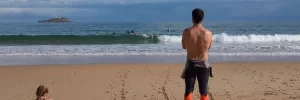
The ferry from Somo disembarks rather conveniently at the café lined Paseo de Pereda, and from this point you need to decide which direction to head; if you had been wondering where you could spend a rest day this is the place.
To your left is the Nuestra Señora de la Asunción Cathedral, built over the location of the previous Abbey of the Holy Bodies whose charge was to hold safe the relics of Emeterio and Celedonio (see history below).
Once you are done with the Cathedral, cross the park and walk tall through the massive arch in the Banco Santander building then turn left, the next building on your right is the small Mercado del Este, a convenient place for a casual lunch and the tourist information office. If you expect more from a market, head to the Mercado de La Esperanza (what better name than The Market of Hope).
Getting to the city’s most emblematic building, the Palacio de la Magdalena, requires a decent walk to the far east of the peninsula. There is a modest fee but the timetable is limited to tours starting on the hour. The Palace was funded by the citizens and used as a Summer residence by King Alfonso XIII until he was removed from power after the formation of the Second Republic in 1931.
So fantastic are the stories surrounding the 8th century founding of the city of Santander that most people pay little notice that it was the Romans that first called this place Portus Victoriae. Their hard work was eclipsed by the arrival by boat of the mortal remains of two of their most famously martyred soldiers, San Emeterio and San Celedonio. Their relics were sent here to be kept safe from the Muslims during the 9th century. Between the brothers, it was Emeterio whose name would be memorialized when Santander, a derivation of the vulgar Latin Sant Emeter, was chosen.
San Juan is celebrated, and bonfires are lit, on the 24th of June.
Santiago is celebrated on the 25th of July. San Emeterio and San Celedonio, patrons of Santander, are celebrated on the 29th of August.
The Fiestas de la Virgen de la Bien Aparecida are held on the 15th of September
Between Santander and Boo de Piélagos there are two routes, the official camino and the Senda Litoral (coastal trail) that follows the coastline north of the city.
The Senda Litoral starts at the ferry terminal and continues along the coast, with the water on your right, all the way around the city. The option is a great deal more scenic than the official camino and it is growing in popularity among pilgrims. At 33km it is the longer option. The official camino turns left at the ferry dock and across the adjacent city park. The path through town is clear and city walking from here to the far end of Santander. At the edge of the park turn left and follow this road; it is the Paseo de Pereda when you begin but changes names along the way. Officially it is the N-611. After passing the large university hospital complex on your left the camino goes through two large roundabouts. At the second roundabout follow the signs in the direction of the Avenida de Cajo, which will take you to the start of Peñacastillo.
Accommodation in Santander.
| Santander Central Hostel 19+€ 38 Booking.com |

|
| Hostel Santander 19-29€ 20 Booking.com |

|
| Hostel & Co 27€ 25 Booking.com |

|
| Albergue de peregrinos Santos Mártires 15€ 12 |
| Plaza Pombo B&B ⭑⭑⭑ Booking.com |

|
The 19th century Iglesia de San Lorenzo (Loreto) is high up on the hill to your left as you enter Peñacastillo.
Nuestra Señora de Loreta, patroness of the city, is celebrated at the start of July.
The camino does not leave the N-611 until it gets to the border between Santander and Peñacastillo, a point which is marked. Here it turns right and then immediately after crossing over the railway it turns left. This road winds a bit but is well marked, taking you under two large highways and into Santa Cruz de Bezana.
Accommodation in Peñacastillo.
Most services located off camino, including the albergues.
Día de la Cruz is celebrated on the 3rd of May and San Roque is celebrated on the 16th of August.
The only tricky part about Santa Cruz is getting to the albergue, which requires a detour from the official camino. It is left-hand turn at the church, at a junction with the CA-300. This will take you back over the railway, and then over the A-67. Immediately after the A-67, where it bends to the right, a set of stairs on your left take you down to the level of the N-611. If you choose this route note that it is not necessary to retrace your steps, this option will rejoin the official camino further down the N-611. The official camino keeps going straight at the church and to Mompia.
Accommodation in Santa Cruz de Bezana.

There isn’t much to Mompía apart from several residential neighborhoods and a hospital.
It is near Mompía that the local utility company has taken to marking their services with yellow arrows. As you would imagine this creates a bit of confusion and it might lead you astray if you are not paying enough attention.
Although the yellow is the same their orientation is usually not; they are drawn upside down with the arrowhead at the bottom. They almost alway involve a bend in the arrow, and they are adjacent to a series of stenciled numbers.
La Virgen del Rosario is celebrated on the first Sunday of October.
The road into Mompía ends and the camino turns left past several residential areas, the Mortera train station, and the Mompía hospital. Past the hospital it turns right at the roundabout. When it gets to the Barrio Vivero it leaves this road for another on the right.
Accommodation in Mompía.
The FEVE train station, church, and albergue are all located in curve in road.
Once upon a time the camino between Boo and Mogro required pilgrims to cross the river along the very narrow FEVE railway bridge. This is now prohibited and enforced by the locals and the police. It is dangerous and very much to be avoided. This leaves pilgrims with three options:
1. Hop on the train at Boo for a two minute journey across the bridge the legit way.
2. Follow the arrows south to cross the river at Arce and then turn back north to Mogro, a well marked journey of 9.4km.
3. Follow the arrows south to cross the river at Arce and then continue on a newly marked alternate from Puente Arce.
Although the town of Boo is new the camino has always passed through this point. Modern travelers have the luxury of a quick train across the Río Pas but ancient pilgrims relied on the Barco de Mogro (the boat of Mogro) to get across; a service which was free to pilgrims.
San José Obrero is celebrated on the 19th of March and San Juan Bautista on the 24th of June.
Once in Boo it is possible to cross the train tracks at the platforms, though do exercise caution. This is the shortest path to the Albergue Piedad. The arrows will otherwise take you around town (it is a small town) on the main road and over the railway.
Accommodation in Boo de Piélagos.
| Albergue Piedad 15€ 20 Booking.com |

|
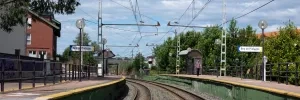
Arce and Puente Arce are technically the same town, though spread out enough to warrant a distinction; the grocery store is near the church at the upper part of town, and the restaurants are closer to the river and bridge.
Nuestra Señora de la Soledad on the 2nd of July, Santa Ana on the 26th of July, and Nuestra Señora de la Anunciación on the 15th of August.
There is now an alternate route for the second half of this option, which goe from Puente Arce to Requejada without having to turn north to go to Mogro. This option would follow near the N-611 which connects Arce to Requejada and Polanco.
Be mindful that new arrows have been painted at a junction after crossing the bridge. This alternate route will take you through Oruña and Mar before entering Requejada via Polanco.
After crossing the bridge in Puente Arce the camino turns right to follow the paved CA-232 all the way to Mogro.

If you have arrived in Mogro via the train from Boo, follow the road from the train station up to the CA-232. On the opposite side of the roundabout there are arrows painted on the stone retaining wall, directing you to the left and uphill to rejoin the official route as it too climbs into town.
The path through town is essentially counter clockwise around the conical hillside to your left. When you get to the far end of town avoid all signs directing you to the Senda Litoral. The camino passes to the left of the Iglesia de San Martín and follows the signs to Cudón, a course which has its ups and downs.
Accommodation in Mogro.
| Casa Rural La Joyuca del Pás ⭑ Booking.com |

|
| Posada Condado de la Mota ⭑⭑⭑ 14 Booking.com |

|
Bar where camino meets busy road.
The entrance to Cudón is marked by the crossing of the CA-232 at which point you will find the bar. Once across this busy road turn left to follow a gravel side street. This path parallels a set of supply pipelines all the way into Requejada; when they head underground you are near the train station, and on your left is an elevated crossing that takes you over the railway and into town.
Accommodation in Cudón.
| Posada La Victoria ⭑⭑ Booking.com |

|
Requejada is a medium sized factory town; the river port here was originally developed to receive iron ore and dispatch wheat but now deals primarily in plastics, soda ash, and brewery machinery. Then as now the going is noisy and hectic all the way down to the crossing of the river into Viveda.
San José is celebrated on the 19th of March.
In Requejada the camino turns right to follow along the busy and noisy N-611 all the way to Barreda.
Note that there may be conflicting arrows after crossing the river. In recent years the camino has changed course and the businesses along the old route through Quevada are still promoting the original way with adverts and arrows. The official camino follows a slightly longer course which avoids very busy road walking for less busy road walking.
The camino passes the entrance to the Barreda train station and comes to a roundabout, turn right here to follow the road over the Río Saja and into Viveda.
The city has two centers which are separated by a smattering of urban development. The only buildings in town of any historical merit are the Iglesia de El Salvador and the Palacio de Peredo.
Viveda was founded by King Alfonso I of Asturias to be a stop along the old Roman road and the Camino de Santiago. The Iglesia de El Salvador began construction as early as 878, making it almost a full century older than the one in Santillana del Mar.
Once over the bridge into Viveda keep to the right at the first roundabout, heading uphill. A short distance later it turns left onto the CA-340 in the direction of Camplengo. This new route is well marked and almost entirely along the road, leading you directly to the Plaza de las Arenas and the Colegiata in Santillana del Mar.
Accommodation in Viveda.
Accommodation in Queveda.
| Albergue Osa de Andara 15€ 20 |
| Posada la Leyenda ⭑ Booking.com |

|
Santillana del Mar is like something out of a movie, which is perhaps why so many are filmed here. It is also an obligatory stop on the tourist bus tour so take a deep breath and get to enjoy the crowds a bit. The streets are lined with shops and restaurants and artist workshops and although the prices are a bit higher you are in one of the “most beautiful villages” of Spain.
The camino enters town near two of its largest and most recognizable landmarks, the Colegiata de Santillana del Mar, and the Palacio Valdivieso (now the Hotel Altamira). On the opposite end of town is the Convento de las Dominicas o Convento de San Ildefonso. In between the two, it would seem that every building is of some historical significance; there isn’t an empty storefront in sight.
If you are bored, and still have not had lunch, perhaps pay a visit to the positively disturbing Torture Museum; sometimes falsely billed as the Inquisition Museum. Further out of town is the Santillana Zoo and the Museo de Altamira (the real reason for the tour buses).
The nearby Altamira Caves are the most important prehistoric site in Spain, and proof that man has called this area home for a very long time indeed. It is the Sistine Chapel of the Paleolithic era and was nearly written off as just another cave were it not for the casual discovery of the 8 year old daughter of the paleontologist tasked with taking a closer look.
Santa Juliana, the patroness, is celebrated on the 28th of June and San Roque on the 15th and 16th of August.
The path through Santillana is well marked with wooden plaques on the stone walls, but they may be difficult to see with the crowds. If you get as far as the CA-131 you have gone too far, turn back and veer to your left towards the main square.
The camino passes the nearby Santillana campsite, climbing up to Arroyo before descending into Oreña.
Accommodation in Santillana del Mar.
| Albergue El Convento 12-16€ 64 |
| Camping Santillana |
| B&B Posada Santa Juliana ⭑ Booking.com |

|
| Albergue Gándara 16€ 14 Booking.com |
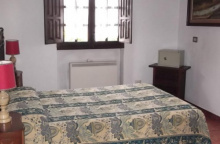
|
| Hotel Conde Duque Santillana del Mar ⭑⭑ Booking.com |

|
| Hotel Museo Los Infantes ⭑⭑⭑ Booking.com |

|
| Parador de Santillana Gil Blas ⭑⭑⭑⭑ Booking.com |

|
| Albergue municipal Jesús Otero 6€ 16 |



The camino keeps to smaller back roads between Oreña and Caborredondo, across farmlands with views to the sea. Along the way you climb up to and pass the 16th century Iglesia de San Pedro before descending into Caborredondo.
Accommodation in Oreña.
Keep on going straight through town and across an overpass. Not far after the camino leaves the road for a path on your right which takes you directly to Cigüenza.
Accommodation in Caborredondo.
| Albergue de Peregrinos Izarra Donativo€ 16 |

|

Cigüenza is located in a valley between two hills and with a population under 100 it is surprising to find so many large estates here. The 18th century baroque Iglesia de San Martín de Tours was modeled after a church in Lima, Peru where its patron (from Cigüenza) lived and made his fortune.
San Pantaleón is celebrated on the 27th of July and San Martín on the 11th of November.
After passing the Iglesia de San Martín the camino rejoins the CA-353 into Cóbreces.

There are a surprising number of architectural heritage sites in Cóbreces, and if you spend the night here you are encouraged to walk the town to take them all in.
They are more or less all adjacent to the camino and include, from east to west: the Colegio de San José (location of Viejo Lucas Albergue), the Ermita de Santa Ana (celebration on the 26th of July), the Iglesia de San Pedro Ad vincula (Saint Peter in chains), the Abadía de Santa María de Viaceli (possibly the first building of its type to be built with reinforced concrete), and the Iglesia de San Felices de Mies.
Or you could stroll to the Playa de Luaña just a short distance away and on the camino, also an option for dining.
There is an alternate route which may cause some confusion in Cóbreces. It turns left at the Iglesia de San Pedro and follows a more southerly path to La Iglesia.
July: Santa Ana on the 26th.
August: San Pedrucu on the 1st and San Roque on the 16th. On the last Saturday of August there is a pilgrimage to the Ermita de Virgen de la Peña, a journey of 18km meant to rid the penitent of all epidemics.
The camino follows the CA-353 all the way through town. It passes all of the albergues as well as the abbey. When it reaches the first main intersection (after the abbey) it turns left and then right again, following the road to the nearby beach. From the beach it climbs up to a small hamlet. Beyond this hamlet it splits into two paths of equal length, to the right is the town of Liandres and to the left is the way to La Iglesia passing the campsite. The path into La Iglesia is downhill, crossing the CA-131 along the way.
Accommodation in Cóbreces.
| Albergue El Pino 18€ 11 Booking.com |

|
| Albergue Viejo Lucas 18€ 159 |
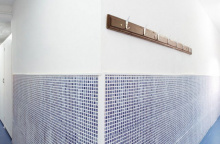
|
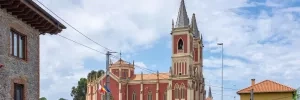
Bars at both the campsite (before town) and in town. The 17th century Iglesia Parroquial de la Asunción is the end point for an annual procession that takes place every July.
Turn right before arriving at the church to the nearby town of Pando.
Accommodation in Barrio de La Iglesia (Ruiloba).
| Camping El Helguero Booking.com |

|

The camino turns right onto the main road in Pando at the church.
From Concha the camino turns left to follow a short trail back to the main road as it enters Comillas, turning left at the campsite.
Fans of Gaudi in particular and architecture in general will be thrilled to find so much to do in Comillas. The camino cuts a short path through town but if you stay the night here do yourself the favor of making a full loop around it so that you can get to the beaches, the harbor, and the headlands overlooking the sea. Doing so requires a bit of a climb but nothing you cannot handle.
The only church of much note is the Iglesia de San Cristóbal, however on the secular end of the spectrum there is no shortage of stuff to see. There seems to have been a Catalan Cultural Invasion at the end of the 19th century. Architects like Gaudi and Martorell and the sculptors Llimona and Roij lent their genius to what are now heritage sites. The two most important and not to be missed buildings are El Capricho by Gaudi, and the Palace of Sobrellano by Martorell. They stand side by side on the hillside. The former is one of the few commissioned works by the famed Catalan architect in Cantabria. It was built as a villa for the adjacent palace, which was built at the same time and whose chapel has furniture designed by Gaudi. After decades of abandonment it is now a museum. The Palace is also a museum and neither are to be missed.
Gaudi did a third project in Comillas, a smoking kiosk for the palace garden purpose built for the visit of King Alfonso XII. Sadly it was moved to Barcelona and has since disappeared. If you do take a walk around town get to the highest point by following signs for the Cemetario. You are aiming for the ruins of the old church. The interior of the old church, which was abandoned by the parish during a feud with the Duke, had been filled by the expanding cemetery. It is a curious sight to see, but the real gem is the modernist sculpture which adorns it. It is known as both El Ángel Exterminador and Ángel Guardián.
The camino has recently changed and now follows the road north. The new route bypasses El Tejo and La Revilla and instead continues along a pedestrian path adjacent to the road. It continues to Oaymbre beach (bar) and then onward to San Vicente de la Barquera along the road.
Agriculture and fishing have long been the pillars of the economy for Comillas, and of the latter it produced some of the finest (and infamous) Whalers of its time. Between the 17th and 18th centuries the free whale was hunted until there were none left to catch, at which point the men traded their harpoons for nets and turned their efforts to sardines. Today it is tourism that brings the euros, the biggest draws being waves, caves, and Gaudi.
Comillas keeps a comprehensive festival calendar, starting with the Cabalgata de Reyes Magos for winter pilgrims passing through on the 5th of January. Later in the year it celebrates Carnaval for the three weeks leading up to Semana Santa (Holy Week). Bonfires on the beach for San Juan on the 23rd of June. Later the local fiesta celebrates San Pedro on the 28th and 29th. San Cristóbal, patron of Comillas, is celebrated on the 10th of July; and less than a week later Santo Cristo del Amparo is celebrated on the 16th. And lastly, on the final weekend of August, the Día del Indiano celebrates the intrepid explorers who set out from Comillas in the mid 19th century to find their fortune in the Americas and the Philippines.
The camino passes through the center of the old town, and does not go near any of the beaches in Comillas; however it is worthwhile to make the detour to visit as the views are exceptional.
After passing through the old town the camino emerges onto the Calle del Marqués de Comillas at a broad park. High up on the hillside to your left is the Capricho de Gaudi and the Palace and Chapel de Sobrellano. Follow the road past these landmarks and straight through the roundabout at the end of the park. You are now in the CA-131 and 2.3km from here the camino splits.
Accommodation in Comillas.


Accommodation in El Tejo - Santa Ana.
| Posada El Teju ⭑ Booking.com |

|
Not really recognizable for anything other than the golf course.
Accommodation in La Revilla.
| Surf House Gerra 25€ 22 |
| Posada La Vieja Escuela ⭑⭑ Booking.com |

|
San Vicente de la Barquera is part of the Camino Lebaniego, you will going to see some new signs with a stylized red cross. The Town Itself is supported by seaside tourism and makes for a nice stopping place. It has a charming old quarter which has hosted pilgrims for centuries; the harbor here served as a common landing point.
In the 13th century Gothic Iglesia de Santa María de los Ángeles you can find the tomb of Antonio del Corro. The writer/humanist/inquisitor is lying down reading a book. Next to the church is the twin-towered Castillo de San Vicente which has a museum, but make the climb for the views. Surrounding the old town are old city walls and the Pilgrim Gate.
On the far far end of town (across the second bridge and further still) is the Santuario de la Barquera, named for the town. The sanctuary is surrounded by beautiful gardens.
San Vicente Mártir is celebrated on the 22nd of January with a farming fair. El Carmen is celebrated on the 16th of July, it is the place to be if sardines are your thing.
The biggest celebration, that of La Folía, is held the second Sunday following Easter Sunday.
After crossing the estuary into San Vicente, the camino proceeds directly through the roundabout at the end of the bridge, and in so doing it doesn’t really go into town. To get to any of the services and transportation, turn right at the roundabout and then retrace your steps to leave San Vicente.
It climbs slightly and crosses over the A-8 into Acebosa.
Accommodation in San Vicente de la Barquera.

Entering Acebosa, the way isn’t entirely clear. Turn right when you get to the road and follow it all the way to Hortigal.
At the fork at the far end of town, keep to the right and follow the road through Estrada and on to Serdío.
Keep on the road through Serdió and be mindful that signs for the Camino Lebaniego are tempting you to leave the trail. Simply keep on the road towards Pesués, passing under the A-8 and over the Río Nansa turn left at the first house. Note: prior to arriving, you pass near Muñorrodero with bar 100m off the camino.
Accommodation in Serdió.
| Hostería El Corralucu Booking.com |

|
From Pesués the camino follows along the tracks, avoiding the traffic along the nearby service road.
Accommodation in Pesués.
| Hostal Baviera ⭑⭑ Booking.com |

|

